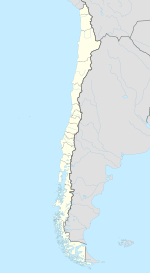Puerto Octay
| Puerto Octay | |||||
|---|---|---|---|---|---|
| Town and Commune | |||||
|
|||||
| Coordinates (town): 40°58′S 72°54′W / 40.967°S 72.900°WCoordinates: 40°58′S 72°54′W / 40.967°S 72.900°W | |||||
| Country | Chile | ||||
| Region | Los Lagos | ||||
| Province | Osorno | ||||
| Founded | 22 December 1891 | ||||
| Government | |||||
| • Type | Municipality | ||||
| • Alcalde | Carlos Mancilla Solís (DC) | ||||
| Area | |||||
| • Total | 1,795.7 km2 (693.3 sq mi) | ||||
| Population (2002 Census) | |||||
| • Total | 10,236 | ||||
| • Density | 5.7/km2 (15/sq mi) | ||||
| • Urban | 3,403 | ||||
| • Rural | 6,833 | ||||
| Sex | |||||
| • Men | 5,391 | ||||
| • Women | 4,845 | ||||
| Time zone | CLT (UTC-4) | ||||
| • Summer (DST) | CLST (UTC-3) | ||||
| Area code(s) | 56 + | ||||
| Climate | Cfb | ||||
| Website | Municipality of Puerto Octay | ||||
Puerto Octay is a town and commune located on the north shore of Llanquihue Lake in Los Lagos Region in the south of Chile. It was settled by German colonists in 1852. Puerto Octay was an important port with regular traffic to Puerto Varas before the coming of railway in 1912.
Its origin dates back to the German colonization in 1852 driven by Bernhard Philippi. With the passage of time becomes one of the major ports of Lake Llanquihue. On 22 December 1891 is established as a municipality, under the Presidency of the Republic Jorge Montt.
Puerto Octay currently has a rich and varied architecture, mostly built of wood, which is the historical reflection of the colonization process, driven by the State of Chile in the mid-nineteenth century, with families coming from Germany.
So constructions emerge as the House Niklitschek, Hotel Haase, Wulf House, current Colegio San Vicente de Paul and House Werner to name a few. What is extraordinary about this city is that despite the lapse of more than 100 years, it is still possible to assess this type of buildings.
As a way to cherish and protect this architectural heritage, now taking place in Puerto Octay a process of declaration of Typical Zone, where they will identify a representative area of identity and history, which will be legally protected by the State of Chile.
Birds: thrush, dove, parrot, rooster from the mountain (extinct), kestrel, heron, sparrows, swallows.
Mammals: cougar, nutria, among others.
Fish: salmon native (locally extinct), mackerel, trout.
...
Wikipedia



